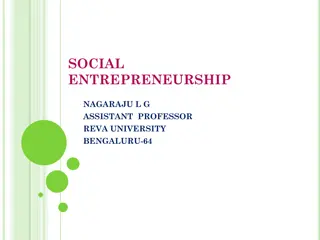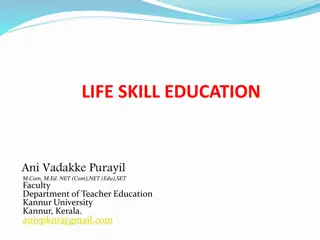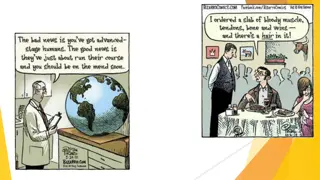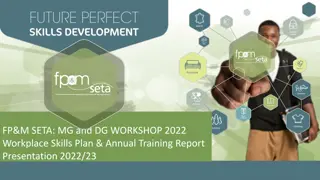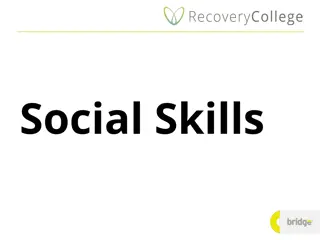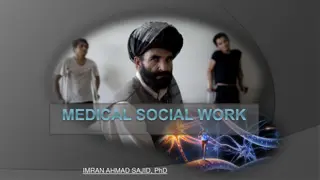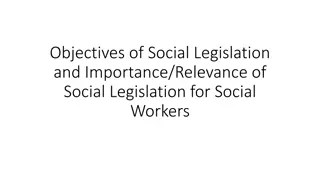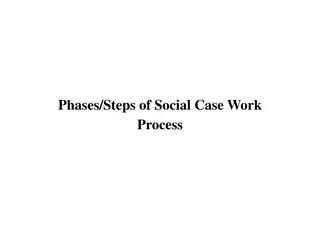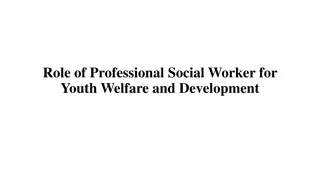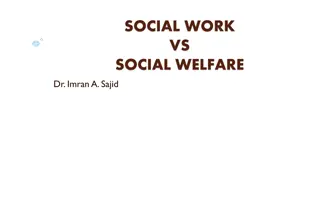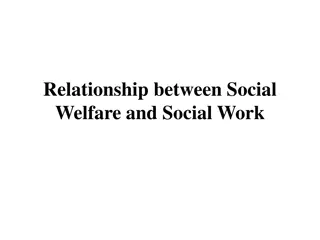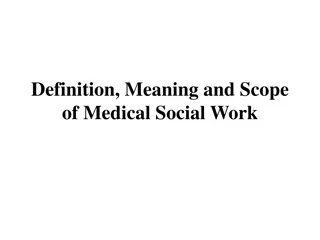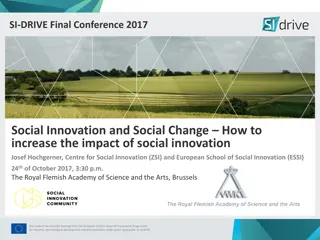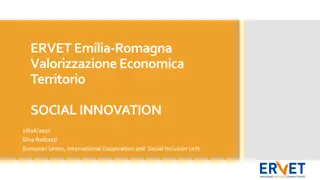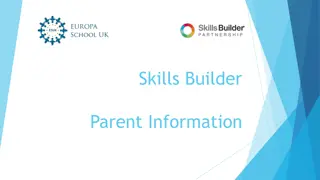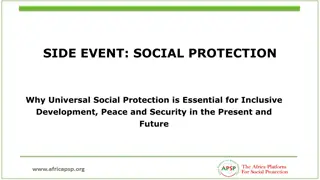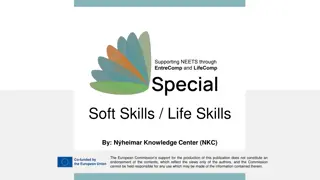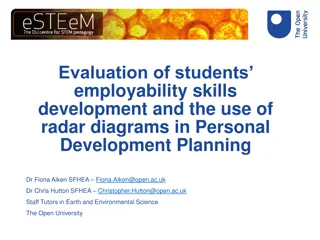Understanding Social Skills Development in Students
Explore the reasons behind students lacking social skills in school settings and analyze the challenges some face even after receiving social skills instruction. Discover the key social skills required for appropriate interactions and the importance of social competence for overall well-being. Delve into the concept of Social Skills Training to help students develop the ability to relate well to others. Consider the impact of different settings on social comfort and the groups of students who often struggle with social challenges.
- Social skills development
- School interactions
- Social competence
- Social Skills Training
- Student challenges
Download Presentation

Please find below an Image/Link to download the presentation.
The content on the website is provided AS IS for your information and personal use only. It may not be sold, licensed, or shared on other websites without obtaining consent from the author. Download presentation by click this link. If you encounter any issues during the download, it is possible that the publisher has removed the file from their server.
E N D
Presentation Transcript
While Youre Waiting Consider the following questions. Why do some students lack the social skills needed to interact appropriately with others in the school setting? Why do some kids, even after social skills instruction, fail to display desired behaviors? When you think of a student in your class who lacks appropriate interaction behaviors, what skills in particular would you like to see him/her display? 1
Socially Skilled: The ability to respond to social activities or environments in a manner that produces, maintains, & enhances positive interpersonal effects. Social Competence OR Social-Emotional Health One s overall social capability the composite or multitude of desires & abilities that result in being socially skilled . So what makes you so socially able? -Motivated to learn appropriate actions -Perceive social situations accurately -Able to identify the skills to use -Able to adequately perform the necessary skills -Sensitive to social feedback -Can tweak behaviors to fit situational requirements -Willing & able to emulate behaviors of others -Able to generalize to appropriate situations . 2
Social Skills Training: The teaching of appropriate interaction skills. Direct instruction via planned lessons & spontaneous training in a teachable moment . Indirectvia prompting, modeling, descriptive praise , & ripple effect . Objective of SST: To help students develop the ability to relate well to others who share an activity and/or setting. 3
Fitting In How comfortable would you feel at: Streetcorner gathering Black barbershop Traditional large-family Chinese New Year meal Knighthood induction ceremony Cultural informants: What is needed for success in each of the above settings/events? Might some of us become more socially skilled than others in the above situations. Why? Might some of your students lack social skills for the school setting? Why? . 4
So which groups of kids struggle the most with social challenges? Mentally Retarded BD A major diagnostic criteria for these disabilities The defining characteristic of BD 3X more likely to be socially rejected than gen. ed. kids 2X LD & MR kids PDD: Aspergers & Autism Low income ( disorganized segment labeled or not) One s social competence affects later life: Job security Love & social relationships Interactions with legal authorities. 5
The Usual Please Anyone here teach social skills? If so: How so? Which curriculum? With whom? How often? If not: Why not? 6
SESSION AGENDA Overview Different types of social skills Why don t our kids have them? Why don t kids show them after they ve been taught? Procedures for teaching S.S. to large & small groups Cultural issues Without a net: Teaching S.S. without $1000 curricula 7
Social Skills Training ^ Different Realms 1. Survival: Form the basic foundation for acquisition of more advanced skills & those in other realms such as: 1. Social interaction 2. Appropriate classroom behavior, work habits, & academic survival skills. (see below) 2. Interpersonal: Enhance chances of successful social interaction with persons of all ages & relationships. 3. Problem solving: Thinking strategies to prevent social problems or escape social discomfort. 4. Conflict resolution: Dealing with highly emotional situations, & resolving existing intrapersonal & interpersonal conflicts. 5. Others are often listed, like Interpersonal perspective taking , Feelings identification , Communication skills , etc. However, we ll address the first four. 8
1. Survival Skills ^ What are the basic social skills? When in someone s presence, Acknowledge the other person Listen attentively & respond appropriately Conduct an accurate on-going self-evaluation of behavior Self reinforce for success What are the basic appropriate classroom behavior, work habits, & academic survival skills? Able & willing to Comply with directions Maintain attention to task Seek assistance, attention & answers appropriately Accept & learn from consequences related to actions. 9
Which skills would you work on developing in Gayle? Video: The Friday spelling test. 10
2. Interpersonal Skills ^ To enhance the chances of social success & building of friendships, one must know how to ? Share Ask for permission Join an activity Contribute to discussions Answer questions Interrupt a busy person or conversation Wait for one s turn or authority figure s attention Begin/End a conversation Give/Accept compliments. 11
Which skills would you work on? (and with whom?) Video: Shelly & lunchtime in the classroom. 12
3. Conflict resolution (intra & interpersonal) ^ Includes social skills for dealing with life s frustrations & threats. They include being able to deal with Being left out Negative peer pressure. Others? Teasing & taunting Accusations Anger directed at you by others The urge or pressure to fight Losing Making mistakes (publicly & privately) Fear Anger . 13
Which skills would you work on? (and with whom?) Video:Craig during down time while waiting to be called to the assembly. 14
Problem Solving & Conflict Resolution ^ When one is involved in or facing a problematic situation , one needs to be able to ? Ask for help Apologize Negotiate. Understand & consider the feelings of others Understand & manage one s own feelings Decide what to do & Make good choices Go with Plan B Respond to failure appropriately (accept it & learn from the experience) Accept consequences (and learn from the experience) Act assertively (not passive or aggressive) Use I (us & we)messages . Click for 3 parts of I message 15
CLICKERS: Which is the properly phrased I message ? (Eye brows through my lesson plan before each class) 1. I get upset when you treat others badly. 2. I need for all of my students to be sitting criss-cross applesauce. 3. I m unable to teach when you re so noisy. 4. I m disappointed to see that you re out of your seat again. 5. All of the above(numbered)statements are properly phrased I messages . 16
Use your garbage mouth again & youre headed to the office. With your attitude, you re gonna end up dead or on welfare. Select a negative YOU Statement . Imagine the situation in which it was said. Rephrase it. (Self or partners) You ve got more excuses than any 12 people I know. You know, it s not that you re stupid. You re just lazy. You re more trouble than you re worth. Why do you always yell out answers? Can t you raise your hand? Why are you out of your seat again? Are you hyperactive or rude? If you re not writing, you re not earning points & can t go. Be careful Atlas! You re going to drop it. BETTER YET: Recollect a negative you message heard (or said) recently. Rephrase it. * Feel free to disapprove of the BEHAVIOR, but NOT the student s CHARACTER. ( Symptom Estrangement or Descriptive Criticism ). 17
Why Dont Kids Have Social Skills? (before instruction) Never learned appropriate behavior Misread social cues given off by others (Neurological?) Don t notice boredom or rejection by others View social forays of others as being threatening Lack of supervision & training by elders An alternative value & response system was taught Know (cognitively)what they should do, but don t have: Practice Self-management due to: Being overwhelmed by emotions Misinterpretation of situational cues. 18
Manners & Boundaries: Civility, Appropriate Behavior & Re-channeling of Negative Energies Includes: 1. Knowing oneself & one s emotions 2. Sizing up a situation quickly & responding within an acceptable conversational or interactional time frame 3. Proficient reading of the signals of others facial expressions & body language voice (volume, intonation) contextual cues 4. Having a practiced, easily accessed set of verbal skills (vocabulary, intonation) physical actions (hand extension, eye contact, smile). 19
Why Dont Kids Have Social Skills? (after instruction) Don t view skills as being useful in their lives. New actions don t bring equalor betterbenefits. Display of new behavior is awkwardly performed. Student is unsuccessful. Views initial failure of new strategies as harbinger of future failure. Know what to do, but past interactions finds them objectionable to others. Due to the interpersonal history, they are quickly rejected or rarely given the chance to display their new skills. Under stress, resorts to old patterns of reaction. 20
The Flume: Class IV section (Bulls Bridge, Housatonic River, CT) 21
Types of Interpersonal Deficiencies ^ Skill deficit: Student cannot I.D. correct response for a social situation; actions are not in the student's behavior repertoire. Performance deficit: Correct social response can be identified by the student when questioned, but is displayed only during the role play situations. How do we respond to each? Skill deficits usually respond to direct instruction. Performance deficits usually require a guarantee that the new behavior will capture at least the same amount of benefits as the current behavioral response (& practice, practice, practice to make it default choice). 22
Teaching as it was & should be Same ol , Same ol As with the teaching of academics, begin with the prerequisite skills & then move on to the more advanced ones. Old School (Pre-NCLB & High stakes testing) Your social skills curriculum will be comprised of realistic, meaningful lessons that teach what is next in line for students to learn (with regard to classroom decorum & social needs). 24
Teaching Social Skills: Whole Class ^ Hold a class-wide discussion on the need for people skills . Have students contribute which skills create a more productive & pleasant learning environment. Select one social skill for the week. With kids, operationalize the behaviors via a T-chart Click to enlarge Click for example (attentive listening) Motivate as usual (posters, charts, point sheets, descriptive praise, etc.) Ingrain the skill Practice immediately (e.g., Active listening & recognition of others practiced via round robin questioning session) Give a daily mini-lesson everyday (or review periodically during left-over instructional time Recognize youngsters for displays & approximations skills http://home.att.net/~clnetwork/socialsk.htm for more detail on teaching the whole class 25
Teaching to Small Groups ^ 1. SELECT target students via assessment (Teach all the kids in a self-contained BD class). 2. Identify reinforcers that MOTIVATE. 3. Identify & define the TARGET behaviors. 4. TASK ANALYZE the target behavior. (if not already done by a packaged program) 5. TEACH. **We ll do it all during a later activity** 26
Teaching social skills Video: Teaching social skills to a small group. NEA video of man with BD kids (3rd or 4th sequence) 27
Jerry-Riggs & MacGyvers ^ Follow the suggested guidelines as best you can, modifying and improvising as necessary. Create groups of 1-5 students with similar skill needs Choose easy-to-master skills 1st Set up rules & procedures Collect data Teach to high-status kids 1st Conduct sessions early in the morning Make the lessons fun Make lessons pertinent to their lives How would you modify any of the following recommended skills to be more applicable to the lives of certain youngsters? (Next slide) 28
Take a minute to review these behaviors. Might some of the preferred actions ever be contra- indicated with certain kids? 29 From Kay Burke http://www.phschool.com/eteach/professional_development/teaching_the_social_skills/essay.html
The American Way? If a student displays actions appropriate in his/her cultural group, but incorrect in mainstream North American culture(e.g., lowering one's eyes when spoken to by an adult, physically fighting when mother's honor is insulted by another), is it appropriate to teach the "right ways" preferred in the schools (and found in social skills kits)? When, how & why would you do so? 30
When does differentiation of behaviors for different situations & settings trump generalization to other settings? Streetcorner kids . Why? Traditional cultural differences are present in the home... Differences in correct behavior such as? Eye contact Body spacing & touch conformities Gender constrictions on body spacing & touch Conversational pauses How one responds to directions one does not wish to follow. 31
Be Like Me Often, packaged social skills programs promote social actions that, while esteemed by adults, would never be shown by any socially accepted kids in the mainstream (or student s social group). In that case, becoming skilled in the new behavior does little to promote acceptance & positive interactions in most of the youngster s lifespace. 32
The Typical Social Skills Lesson (desired outcome) Situation: Victor shows his yellow lunch card to the cashier. Joe, standing behind him with two other kids (from higher economic standing) taunts Victor saying Hey Po Boy Eating on my parents taxes again? How do you like the food I m buying for you? Joe s friends chuckle. Victor: Please mind your own business. Joe: Yeah, sure dirtball. You just go on over to your friends at the trailer trash table. Victor: Joe, I don't appreciate the way you talk about me and my family. (Victor walks away.) 33
Casey:Yo' Punk! Wsup with not passing the ball to me under the net? Open yo eyes, sleepy. Role Play #1 (to be followed by discussion). Kip:Man, my blindfolded hook beats yo best lay up. Casey:I ain t seein all dat today. Yo J is broke. Kip:Man, you be gettin used like soap by yo man the whole game. Don t be talking no trash to me til you get yo game on, Bubbles. Casey:Your mama throws better when she s workin the pole, J man. Kip:Oh playin house, huh? N----er, yo mama score more times today than you. She better at lay downs than yo lay ups. (Casey moves aggressively toward Kip who says Bring it on soapy. ). Situation:Two teams are playing basketball. Time is running out & the score is close when Kip & Casey have a 2-on-1 fast break. The sole defender goes out to guard Kip who pulls up to miss a long-distance jump shot from beyond the 3-point circle. Casey is furious because he was wide open under the basket hoping for the ball. 34
Role Play #2(to be followed by discussion) Casey:Hey, Kip. I was open under the hoop. Pass the ball, man.(Respectful with suggestion. Disagreement is with the problem, not the person.) Kip:Alright, man. I'll get you next time. I thought I could hit it or you d get the rebound. (Has opportunity to respond with reason) Casey:Let's just get the ball back, Bro. (Focus on solution & keeping the bond) Outcome: They play hard. Kip gets a rebound and passes the rock down-court to Casey who scores on a break-away lay-up. 35
Micro-Cultures: Teaching Tough Kids^ Joke & laugh about the new behaviors in order to ? Address & defuse the issues up front (& again later) Switch to serious tone to talk about their importance. Why would resistant kids want to use the new actions if they re contra-indicated in their milieu? What are the benefits outside of their present life- space? Job interviews, disciplinary meetings, police stops, meeting new people outside of group, etc. We must also engage in character education in order to avoid ? creating better manipulators. 36
From Talk to Action During the rest of today s session, we ll be putting this information into practice Remembering that each lesson or experience should be processed & evaluated in 2 ways: How well was the behavior displayed? (Social skills) What has been learned from the experiences? (Cognitive skills) In other words Students report on what they have learned from a role play or real-life attempt as well as their progress in displaying appropriate social skills via the 5 W & HA! example (click here). 37
Select Target Students ^ Student s Self Assessment 1st step - Students complete (by self or in conference) Teaching Social Skills: Student Self-Report Form (elem.) OR How Are My Social Skills Checklist (adolescent) (Pages 1 - 4 in your packet) 1. 2nd step Use the information for ? - understanding of the student - determining accuracy of self perceptions - conversation starters to attempt to motivate active participation from the student. ?Any thoughts on the questions asked of the students? If you re enrolled in an online staff development course, you can find a checklist at: http://www.4-h.uiuc.edu/opps/pyd_club/lp_careadult_socialskills.pdf 38
Teachers Assessment ^ 1st step Complete the Social Competence Screening Form (SCSF) (To identify students in most need) (Page 5 in packet) 2nd step Complete the Social Skills Matching Form , circling the numbers of the students (from the SCSF) who need instruction in each of the 23 skills listed (or others you identify). (Pages 6-7 in packet) 3rd step - Use info from the SSMF to form groups for each social skill unit. Your Task: Complete the teacher forms. Take 10 minutes to do so. Tom is available to explain & assist. If you re enrolled in an online staff development course, you can find a checklist at: http://www.centraliowachildcare.org/healthconsulting/schoolagescreentoolkg.pdf 39
2. Identify reinforcers that will motivate participation. ^ Move Clifford along the wall toward Emily 0439734312-crop-325x325 Raffle tix Group or individual points toward event or privilege (1-3 points for each 5 min. review of attention/participation) Progressively open or close window blinds Others that might work for your students? 40
3. Identify & define target behaviors. ^ Decide upon the most needed social behavior. Define the behavior so precisely that everyone agrees as to which actions are to be demonstrated. Instead of Student will be polite. , identify the actions: Students will say Thank you. when someone does something nice for them or gives them something. Students will say Excuse me. when needing to interrupt conversations or concentration of others. Rather than uttering a directive when seeking assistance, students will make a request that includes the word Please . 41
Precision Definitions: Brainstorm with me Asking permission: Student verbally requests the privilege of engaging in an action. Staying out of fights: Student walks away from verbal or physical aggression aimed at him/her. Showing Sports(wo)manship: Student accepts referee s call without comment. abides by the rules & their intent. congratulates an opponent at end of a contest. 42
Your task: (5 minutes) ^ Go to your completed Social Skills Matching Form By yourself or with your colleague(s) Decide which social skill is most important to teach Precisely define the behavior so that it is: specific to the setting and students of concern able to be identified as displayed or not displayed by anyone observing the youngster(s). Be ready to offer your definition to our group (if selected randomly by Dr. Mac from the roster). 43
4. Task analyze the target behavior ^ Delineate the simple behaviors that comprise the complex behaviorally defined action. They might be displayed either: in sequential order at the same time as other sub-behaviors Same time: Listening Face up with eyes on speaker Nose pointed toward speaker Lips closed except for positive sounds (explained) Be able to paraphrase message & comment respectfully. 44
Sub-skills in Sequential Order: Respecting the Opinion of Others ^ Offer an empathy statement: I know that you feel that way, but I can see how you might think that way, however Give an assertive (not hostile) statement of feelings: (If applicable) this really gets my goat. it s frustration to have my views distorted. Disagree on subject without attacking speaker: I view it differently, because The way I see it, the truth is that . 45
Another One in Sequential Order Following directions Listen carefully to the direction Restate the direction (out loud or to self) If confused, ask for clarification Attempt to accomplish the task Ask for assistance if needed. 46
Your Task (5 minutes): Use T.A. to Break Down the complex, multi-step behavior ^ Task analyze the behavior that you selected as being the most needed. OR Select Greeting others Familiar (family & friends) Unfamiliar Adult Peer Same gender Other gender Younger Older ORSelect a behavior from the Social Skills Matching Form . 47
5. TEACH ^ Plan out a unit for the teaching of the behavior. Do so as you would for a unit on academic material. Would anyone like to share a couple of ideas of some parts of lessons that would be in their unit? Examples of social skills units planned using today s process can be found at: www.behavioradvisor.com/SocialSkills.html Essentially, the steps to follow when teaching social skills are 48
Tell em: Introduce & discuss Whats in your intro? ^ Observations on class behavior toward others Belief in ability to do better Overview of program Why & how program will benefit them. How will it benefit them? ? Show em:Model the new behavior(perhaps with co- teacher) (YouTube social skills training ). Watch em: Role play Share with em: Feedback Send em forth: (perhaps placed in situations where can use skill) Positive recognition for use (perhaps prompted at 1st) Homework assignments (5W & HA sheets) Surprise tests. Bring em back: Periodic review sessions Role play troublesome situations Set new goals . Sequence #4 of NEA video ( connecting ) here. Male T with BD students.? 49
6. Follow-up ^ Monitor performance. Collect data for evaluation & decision- making purposes(Pages 12 -13 in your packet) Teach new social skills while periodically revisiting old ones. Work on generalization (while observing the cautions we mentioned)... 50



